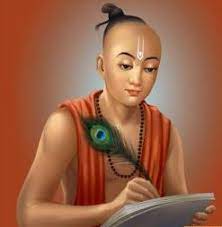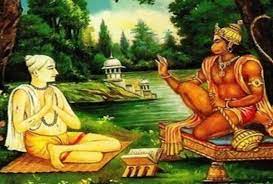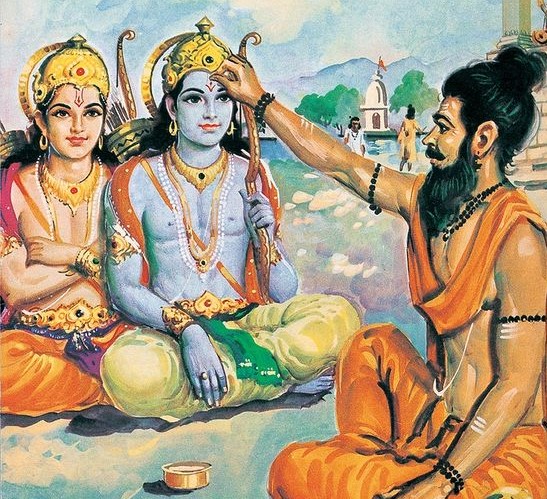Goswami Tulsidas was a Vaishnav Hindu saint and poet of sixteenth century. He wrote several works in Sanskrit and Awadhi ,but is best renowned for composing Hanuman Chalisa and the Awadhi version of Hindu epic ‘Ramayana’ called ‘Ramcharitmanas’.
He is one of the greatest writer in Indian history and has contributed a lot to traditional Indian literature , especially in vernacular languages. The traditional folk songs and local drama plays are inspired by the works of Tulsidas. He is also believed to be the incarnation of Maharishi Valmiki ( original author of Ramayana in Treta Yuga). His main aim behind writing Ramcharitmanas was to make the story of Lord Rama to be available to the common people and not just the learnt Brahmins.
Tulsidas : Birth
According the astrological predictions , Tulsidas ji was born on the seventh day of Shukla Paksha in the month of Shravan(July – August) in 1532. The government of Uttar Pradesh officialy declared Sookar Kshetra Sooran (district Kashganj) as the official birthplace of Tulsidas. It is a village on the banks of river Ganga.
These date and location of his birth are highly contradicted by other scholars .This is because Tulsidas has rarely mentioned his details in any of his works.
His father name was Atmaram Dubey and mother name was Hulsi. Tulsidas was a Saryupareen brahmin ( a lineage of brahmin who lived near the river Saryu) . He belonged to the Parashar gotra.

Tulsidas named ‘Rambola’
Tulsidas was born after staying in his mother’s womb for twelve months.When he was born , he showed strange signs. His health and looks were like that of five year old child. He had all 32 teeth. Instead of crying after birth,he uttered “Ram -Ram”. So , he was named ‘Rambola’ , which means the one who recites name of Rama.
Tulsidas birth was accompanied by bad omens, and according to astronomical predictions, there was an immediate danger to the life of his father after his birth. He was abandoned by his parents on the fourth day of his birth and was taken care of by their female servant named ‘Chuniya’.
She looked after him for five years before passing away . After her death,Tulsidas led his life as an abandoned orphan and wandered from place to place and begged for food.
Upanayana Samskara
Excerpt from Ramcharitmanas मैं पुनि निज गुर सन सुनी कथा सो सूकरखेत । समुझी नहिं तस बालपन तब अति रहेउँ अचेत ॥ mai puni nija gura sana sunī kathā so sūkarakheta । samujhī nahi̐ tasa bālapana taba ati raheu̐ aceta ॥ And then, I heard the same narrative from my Guru in a Sukarkhet (Varaha Kshetra) Soron. I did not understand it then, since I was totally without cognition in childhood.
Narharidas , a Vaishnav saint adopted tulsidas at the age of six . He was given the title of ‘Tulsidas’ and the ‘Virakta Diksha’ (initiation of renunciation). At the age of seven the sacred thread ceremony called ‘Upanayana’ was performed for him at Ayodhya.
Tulsidas heard the first narration of Ramayana from his guru in Varaha kshetra Soron (in kashganj ,Uttar Pradesh) .
Tulsidas Marital Status
According to popular belief Tulsidas was married to Ratnavali. He was so passionately attached to her that he could not bear a separation of one day from her .Once she went to her father’s house without informing Tulsidas about her visit. Out of attachment Tulsidas went to see her at her father’s house at night.
His wife felt it as a humiliation and said to Tulsidas :
“My body is but a network of flesh and bones. If you would develop for Lord Rama even half the love that you have for my filthy body, you would certainly cross the ocean of Samsara and attain immortality and eternal bliss”.
Tulsidas left her at the very moment and lived as an ascetic . He then moved to Varanasi , and studied Sanskrit literature, scriptures, Vedangas, Jyotish and schools of Hindu Philosophy .He travelled to several pilgrimage for the next fourteen to fifteen years.
During his travel he went to far off places including the four Dham – Badrinath,Dwarka ,Puri and Rameshwaram. He also went to Lake Mansarovar (presently in Tibet).It is believed that here he had a sight of Kakabhushundi ( the crow who is one of the four narrators in Ramcharitmanas).
Some scholars believe the story of his marriage to be a later interpolation in the lifestory of tulsidas. They believe that he was a bachelor throughout his life.
Darshan of Hanuman and Rama

The detailed account of Tulsidas meeting Hanuman and Ram is given by Priyadas ( a contemporary poet and saint ) in his work ‘Bhaktirasabodhini’.
Tulsidas used to visit outside Varanasi for his morning nature call . When he returned he offered the remaining water to a tree , which was the residence of a Pret (a type of ghost) . This would quench his thirst. Pleased by this act of Tulsidas ,the ghost asked Tulsidas to ask him a boon.
Tulsidas said that he wanted to see Lord Ram face to face. The ghost guided him and said that his Bhajans were attended by an old men daily who sat at the end of the gathering . The old man was Hanuman in disguise. The way to meet Rama would be further told to him by Hanuman himself. The place where he met Hanuman is now the Sankatmochan Hanuman temple of Varanasi.
ग्रह भेषज जल पवन पट पाइ कुजोग सुजोग। होहि कुबस्तु सुबस्तु जग लखहिं सुलच्छन लोग।।7(क)।। सम प्रकास तम पाख दुहुँ नाम भेद बिधि कीन्ह। ससि सोषक पोषक समुझि जग जस अपजस दीन्ह।।7(ख)।। जड़ चेतन जग जीव जत सकल राममय जानि। बंदउँ सब के पद कमल सदा जोरि जुग पानि।।7(ग)।। देव दनुज नर नाग खग प्रेत पितर गंधर्ब। बंदउँ किंनर रजनिचर कृपा करहु अब सर्ब।।7(घ)।। --- Ramcharitmanas (1.7 doha) Tulsidas wrote about the Pret
The next day tulsidas observed the old man and caught hold of his feet and said “Prabhu Darshan Dein” – “O Lord please show your real form ” . Hanuman revealed his real form and asked him to go Chitrakoot to see Lord Ram .
Tulsidas moved to Chitrakoot and lived in an ashram at Ramghat. While performing circumambulation of Kamadgiri mountain ,Tulsidas saw two princes sitting on horseback passing from there. He could not recognise them and moved ahead. The next day Hanuman told him that they were Rama and Lakshman .
Tulsidas repented of his act of ignorance. He was pacified when Hanuman told him that the two brothers would again visit him the next morning.
The next day , two young boys visited him and asked him to apply the tilak of sandalwood paste on their forehead. This time Tulsidas recognised them and had full vision of Rama. He was enchanted by their looks and lost his senses. Then he applied the tilak of sandalwood paste on the forehead of Ram and Lakshmana with his own hands. In reference to this incident there is a famous proverb:
चित्रकूट के घाट पर हुई संतन की भीर तुलसीदास चन्दन घिसे तिलक देते रघुबीर. Chitrakoot ke ghat par hui santan ki bheed tulsidas chandan ghise tilak kare raghubeer

Tulsidas also had vision of sage Yajnavalkya and Bharadwaja( one of the Saptarishis) under a Banyan tree.
Major works of Tulsidas
In regards to his poetry Tulsidas is called the ‘ Emperor of metaphor’ .He is the legend in the use of similies. It is said that:
कविता करके तुलसी न लसे कविता लसी पा तुलसी की कला । Tulsidas did not shine by composing poetry, rather it was Poetry herself that shone by getting the art of Tulsidas
Majority of his works are in Awadhi and Braja :
- Awadhi – Ramcharitmanas , Parvati Mangal ,Ramlala Nahachhu, Barvai Ramayan, Janaki Mangal and Ramagya Prashna
- Braja – Krishna Gitavali, Gitavali, Sahitya Ratna, Dohavali, Vairagya Sandipani and Vinaya Patrika.
Besides these works Hanuman Chalisa, Hanumanashtak, Hanuman Bahuk and Tulsi Satsai are some of his most popular works . Out of all these works Vinay Patrika is his last composition.
Tulsidas view on other deities
Tulsidas equates Guru as an incarnation of Shiva . Other deities are revered at the beginning of his works .Tulsidas asks them to grant him devotion for Lord Rama.At the beginning of the Vinayapatrika, he bows to Ganesh, Surya, Shiva, Devi, Ganga, Yamuna, Varanasi and Chitrakoot, asking them for devotion towards Rama.
Tulsidas addresses Rama as the greatest means of salvation from the chain of repeated birth and death . The devotion for Rama is open for everyone and not just limited to the highly learnt class of society.
Departure from the world
He spent most of his time in Ayodhya and Varanasi . One of the Ghat on the banks of river Ganga is called Tulsi Ghat in his honour. It is said that he performed severe penance at this place.
Tulsidas left his mortal coil and entered the Abode of Immortality and Eternal Bliss in 1623 A.D. at the age of ninety-one at Assighat in Varanasi ( exact date is contradicted).
The importance of saints, philosophers and intellectuals in shaping the minds and social conduct of people was realised quite early in India. Our contemporary literature became the artistic medium of passing on the values to younger generation.
Goswami Tulsidas ji was one such iconic figure who is responsible for preserving Hindu culture and traditions .He is acclaimed as one of the greatest poet in the world literature. His writings has a huge impact in shaping the art and culture of India that can be seen till date as streetplays (Ramleela) classical music and Hindi literature.
Jai Shree Ram !